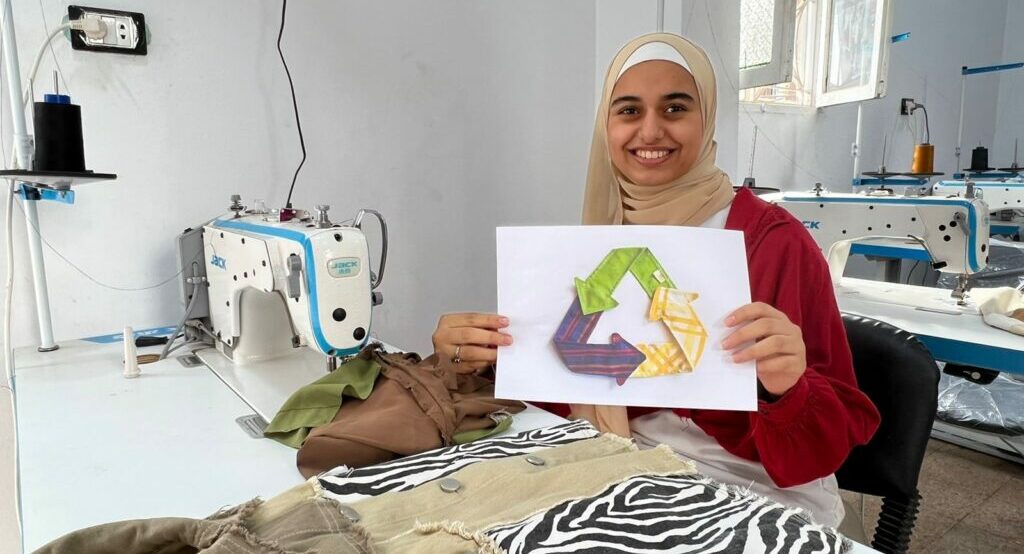Pioneering Sustainable Fashion in Egypt’s Poorest Provinces
MONOFEYA, Egypt— In a province where "sustainable fashion" is scarcely understood among its 4.7 million residents, many of whom live below the poverty line, a radical endeavor has emerged. Amidst Monofeya’s economic struggles, Green Fashion—a business predicated on upcycling fabric waste—has diverted approximately 940 tons (850 metric tons) of textiles from incineration or landfill over the past five years.
“We observed the vast quantities of textile waste and recognized an opportunity for creative manufacturing and environmental solutions,” stated Amgad Moustafa, co-founder of Green Fashion. Since its inception in 2018, the company has collaborated with 50 textile factories to salvage surplus and waste materials, employing around 200 women who revitalize these materials into new garments.
Egypt’s garment industry, a significant economic pillar accounting for 4% of the GDP, produces approximately 234,000 tons (212,000 metric tons) of textile waste annually, as recorded by a UN study. This industry is also a notorious environmental offender on a global scale. The United Nations reports that a single pair of jeans necessitates 10,000 liters of water—sufficient to sustain one person for a decade. Moreover, recent McKinsey studies reveal that the fashion industry contributes 3-10% of global greenhouse gas emissions, with its processes making up a quarter of industrial water pollution and accounting for 20-35% of microplastics in the oceans. The UN has branded fast fashion as "an environmental emergency."
The adverse economic conditions in Egypt, the most populous country in the Arab world, have further spurred interest in recycled and upcycled apparel. As inflation drives up the cost of new garments, consumers increasingly turn to thrifting and custom-made options, thereby reducing fabric waste and engendering job creation and innovation.
“Sustainability has historically permeated all levels of Egyptian society,” notes Esraa Aburehab, a consultant in sustainability and environmental development. Repurposing clothes was once a ubiquitous practice, wherein items within families would circulate from one relative to the next.
However, mass production and the rise of fast fashion shifted these sustainable practices. Yet now, with the economic strain, the pendulum is swinging back towards reuse and repurposing.
Rahma Youssef, a teacher from Suez, reflects on the era of affordable travel to Cairo for shopping excursions. "What once covered several pieces now barely buys one," she laments. Thrifting and custom-made clothing have become viable alternatives for her and her sister.
Basma Tawakol, founder of Dayra, an online thrifting store, attests to this rising tide of sustainable fashion. “Currency devaluations prompted people to seek lower-cost clothing options,” Tawakol says. “Surprisingly, our customer base includes not only middle and lower-income groups but also the upper class.”
Since launching in 2020, Dayra has consistently released collections of approximately 12 upcycled pieces every few months. Similarly, Green Fashion has excelled in mass-producing upcycled garments from defective and surplus fabrics at a fraction of the cost of new materials.
Training and employment are also integral to Green Fashion’s mission. The company offers comprehensive six-month training programs for new tailors, focusing on sewing and recycling techniques, thereby empowering women who might otherwise lack job opportunities.
“Our initiative supports environmental goals and creates socio-economic benefits by empowering women who previously had minimal income,” Moustafa elaborates.
One such beneficiary, Sohair Asfour, a homemaker until her husband lost his job in 2018, credits Green Fashion with transforming her life. “I learned embroidery and sewing, and now I assist in training newcomers,” says Asfour.
The narrative of sustainable fashion extends even to teaching upcycling techniques, such as at workshops conducted by the initiative From Waste to Good Taste, co-founded by Youssre Abdelkader. These sessions, which began in 2021, attract a diverse age group eager to learn patchwork and other upcycling methods.
Green Fashion recently expanded its operations to the governorates of Gharbia and Aswan, aiming to employ 300 more women and upcycle an additional 1,000 metric tons (1,100 tons) of waste by the end of 2024. They also plan to introduce a fabric donation vehicle in Egypt’s rural regions and universities.
“We aspire to disseminate the concept of sustainability, one person at a time,” Moustafa concludes.
For further insights, please refer to the original articles on Ensia and Egab’s collaboration.
Source: Egab
